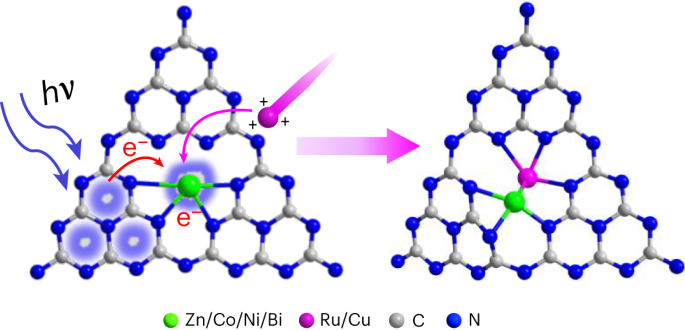Photo-induced synthesis of heteronuclear dual-atom catalysts
0 CHEMISTRY, MULTIDISCIPLINARY
引用次数: 0
Abstract
Dual-atom catalysts (DACs) have garnered significant interest due to their high atom utilization and synergistic catalysis. However, there is no universal synthetic method to precisely synthesize DACs. Here we propose a ‘navigation and positioning’ strategy for precise and scalable synthesis of a series of heteronuclear M1M2 DACs on polymeric carbon nitride (PCN). The primary nucleation sites, M1-PCN, were created by calcining urea and M1 metal salts. Upon light irradiation, the accumulated photoelectrons at the M1 site can navigate and position the second metal ion, M2, close to the M1 site, enabling the precise synthesis of heteronuclear DACs. Density functional theory calculations demonstrate that the hybridization of the Zn s orbital (M1) and Ru d orbital (M2) benefits the formation of stable ZnRu DAC on PCN. The ZnRu DACs were then investigated for photocatalytic hydrogen evolution. It was shown that the Ru site reduced H+ to H* and the Zn site acted as the H* desorption site, thus synergistically boosting activity. A navigation and positioning strategy is proposed for the scalable synthesis of a series of heteronuclear dual-atom catalysts via irradiation. It is shown that photo-induced electron accumulation at the M1 site can attract an M2 metal cation, forming heteronuclear dimers with high purity.


光诱导合成异核双原子催化剂
双原子催化剂(DAC)因其高原子利用率和协同催化作用而备受关注。然而,目前还没有通用的合成方法来精确合成 DACs。在此,我们提出了一种 "导航定位 "策略,用于在聚合氮化碳(PCN)上精确、可扩展地合成一系列异核 M1M2 DAC。M1-PCN 是通过煅烧尿素和 M1 金属盐形成的主要成核位点。在光照射下,M1 位点积累的光电子可以导航并定位第二个金属离子 M2,使其靠近 M1 位点,从而实现异核 DAC 的精确合成。密度泛函理论计算表明,Zn s 轨道(M1)和 Ru d 轨道(M2)的杂化有利于在 PCN 上形成稳定的 ZnRu DAC。随后,研究人员对 ZnRu DAC 进行了光催化氢气进化研究。结果表明,Ru 位点将 H+ 还原成 H*,而 Zn 位点则作为 H* 的解吸位点,从而协同提高了活性。
本文章由计算机程序翻译,如有差异,请以英文原文为准。
求助全文
约1分钟内获得全文
求助全文

 求助内容:
求助内容: 应助结果提醒方式:
应助结果提醒方式:


